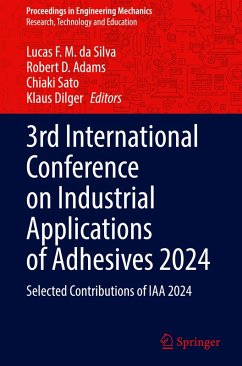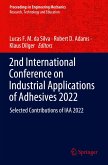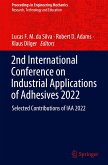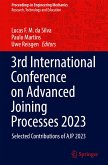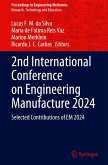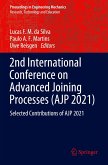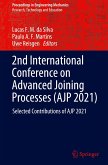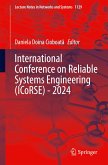3rd International Conference on Industrial Applications of Adhesives 2024
Selected Contributions of IAA 2024
Herausgegeben:da Silva, Lucas F. M.; Adams, Robert D.; Sato, Chiaki; Dilger, Klaus
3rd International Conference on Industrial Applications of Adhesives 2024
Selected Contributions of IAA 2024
Herausgegeben:da Silva, Lucas F. M.; Adams, Robert D.; Sato, Chiaki; Dilger, Klaus
- Gebundenes Buch
- Merkliste
- Auf die Merkliste
- Bewerten Bewerten
- Teilen
- Produkt teilen
- Produkterinnerung
- Produkterinnerung
This book offers selected papers presented at the 3rd International Conference on Industrial Applications of Adhesives, held in Cascais, Portugal, March 7-8, 2024. The goal of the conference was to provide a unique opportunity to exchange information, present the latest results as well as to discuss issues relevant to industrial applications of adhesives. Special contributions on formulation of adhesives, pressure sensitive adhesives, adhesive properties, design of adhesive joints, and durability of adhesive joints have been selected for this volume. This work will appeal to a wide readership,…mehr
Andere Kunden interessierten sich auch für
![2nd International Conference on Industrial Applications of Adhesives 2022 2nd International Conference on Industrial Applications of Adhesives 2022]() 2nd International Conference on Industrial Applications of Adhesives 2022149,99 €
2nd International Conference on Industrial Applications of Adhesives 2022149,99 €![2nd International Conference on Industrial Applications of Adhesives 2022 2nd International Conference on Industrial Applications of Adhesives 2022]() 2nd International Conference on Industrial Applications of Adhesives 2022149,99 €
2nd International Conference on Industrial Applications of Adhesives 2022149,99 €![3rd International Conference on Advanced Joining Processes 2023 3rd International Conference on Advanced Joining Processes 2023]() 3rd International Conference on Advanced Joining Processes 2023149,99 €
3rd International Conference on Advanced Joining Processes 2023149,99 €![2nd International Conference on Engineering Manufacture 2024 2nd International Conference on Engineering Manufacture 2024]() 2nd International Conference on Engineering Manufacture 2024149,99 €
2nd International Conference on Engineering Manufacture 2024149,99 €![2nd International Conference on Advanced Joining Processes (AJP 2021) 2nd International Conference on Advanced Joining Processes (AJP 2021)]() 2nd International Conference on Advanced Joining Processes (AJP 2021)127,99 €
2nd International Conference on Advanced Joining Processes (AJP 2021)127,99 €![2nd International Conference on Advanced Joining Processes (AJP 2021) 2nd International Conference on Advanced Joining Processes (AJP 2021)]() 2nd International Conference on Advanced Joining Processes (AJP 2021)127,99 €
2nd International Conference on Advanced Joining Processes (AJP 2021)127,99 €![International Conference on Reliable Systems Engineering (ICoRSE) - 2024 International Conference on Reliable Systems Engineering (ICoRSE) - 2024]() International Conference on Reliable Systems Engineering (ICoRSE) - 2024127,99 €
International Conference on Reliable Systems Engineering (ICoRSE) - 2024127,99 €-
-
-
This book offers selected papers presented at the 3rd International Conference on Industrial Applications of Adhesives, held in Cascais, Portugal, March 7-8, 2024. The goal of the conference was to provide a unique opportunity to exchange information, present the latest results as well as to discuss issues relevant to industrial applications of adhesives. Special contributions on formulation of adhesives, pressure sensitive adhesives, adhesive properties, design of adhesive joints, and durability of adhesive joints have been selected for this volume. This work will appeal to a wide readership, from practitioners through graduate students to researchers working in this field.
Produktdetails
- Produktdetails
- Proceedings in Engineering Mechanics
- Verlag: Springer / Springer Nature Switzerland / Springer, Berlin
- Artikelnr. des Verlages: 978-3-031-69502-5
- 2025
- Seitenzahl: 136
- Erscheinungstermin: 17. September 2024
- Englisch
- Abmessung: 241mm x 160mm x 13mm
- Gewicht: 345g
- ISBN-13: 9783031695025
- ISBN-10: 303169502X
- Artikelnr.: 71233248
- Herstellerkennzeichnung Die Herstellerinformationen sind derzeit nicht verfügbar.
- Proceedings in Engineering Mechanics
- Verlag: Springer / Springer Nature Switzerland / Springer, Berlin
- Artikelnr. des Verlages: 978-3-031-69502-5
- 2025
- Seitenzahl: 136
- Erscheinungstermin: 17. September 2024
- Englisch
- Abmessung: 241mm x 160mm x 13mm
- Gewicht: 345g
- ISBN-13: 9783031695025
- ISBN-10: 303169502X
- Artikelnr.: 71233248
- Herstellerkennzeichnung Die Herstellerinformationen sind derzeit nicht verfügbar.
Lucas FM da Silva is Full Professor in the Department of Mechanical Engineering at the Faculty of Engineering of the University of Porto (FEUP). He obtained his PhD in structural adhesive bonding of composites from the University of Bristol (United Kingdom) in 2004 and Aggregation from FEUP in 2011. He leads the Advanced Joining Processes Unit (AJPU) of the Institute of Science and Innovation in Mechanical Engineering and Industrial Engineering (INEGI) composed of approximately 40 members post-doc, doctoral students and master students. The work includes the development welded joints, joints by plastic deformation and adhesively bonded joints. The research methodology is based on the mechanical characterization of materials and joints in terms of strength and fracture, modeling with analytical models and finite elements supported by careful experimental tests. Robert D. Adams is Emeritus Professor of Applied Mechanics at the University of Bristol and Visiting Professor at the Universities of Oxford and Oxford Brookes. In 2011, he was awarded the R.L. Patrick Fellowship of the US Adhesion Society. He has been Joint Editor-in-Chief of the International Journal of Adhesion and Adhesives since 1999. Chiaki Sato is Professor of the Laboratory for Future Interdisciplinary Research in Science and Technology, Tokyo Institute of Technology. B.E., M.E. and Ph.D. of mechanical engineering were obtained from Tokyo Institute of Technology. Main topics: Mechanics of adhesively bonded joints. Klaus Dilger is university professor at the Institute of Joining and Welding, Technische Universität Braunschweig since 2002 and board director of the Open Hybrid LabFactory e. V. (OHLF) since 2013. He has studied mechanical engineering at Technical University of Munich. Afterwards he had been research assistant at Technische Universität Munich and received his doctor degree (Dr.-Ing.) in 1991. He was assistant professor at the chair of joining technology at TU Munich and than professor for adhesive bonding technology at the University of Aachen (RWTH). He received an honorary professorship (Prof. h.c.) from the Kutaisi State University, Georgia in 2004. Prof. Dilgers main research activities are in the field of lightweight design and manufacturing of modern mobility providers. He has published more than 950 papers and book publications as author, co-other and editor.
Part I. Formulation of adhesives.- Chapter 1. Blend Technology to Enable Lignophenolic Resins on Industrial Scale.- Part II. Pressure senstive adhesives.- Chapter 2. SPECSIL - Silicone pressure-sensitive adhesives for special applications - summary of the project.- Chapter 3. Influence of diatomite on the self-adhesive properties of silicone pressure-sensitive adhesives.- Chapter 4. Influence of kaolin on the self-adhesive properties of silicone pressure-sensitive adhesives.- Chapter 5. Influence of citrine on the self-adhesive properties of silicone pressure-sensitive adhesives.- Part III. Adhesive properties.- Chapter 6. Inductive curing of 2C epoxy adhesives in foil to foil specimens.- Part IV. Design of adhesive joints.- Chapter 7. Enhancing mechanical performance of adhesive joints with carbon nanotubes: Optimizing ultrasonication through viscosity analysis technique.- Chapter 8. Experimental and numerical study for the optimization of process parameters in laser welded and adhesively bonded PBT GF30 fillet joints.- Part V. Durability of adhesive joints.- Chapter 9. Influence of Saline Environment Exposure on the Fatigue Behavior of
Adhesive Joints in Carbon-Epoxy Composites for Mode I and II Fracture.
Adhesive Joints in Carbon-Epoxy Composites for Mode I and II Fracture.
Part I. Formulation of adhesives.- Chapter 1. Blend Technology to Enable Lignophenolic Resins on Industrial Scale.- Part II. Pressure senstive adhesives.- Chapter 2. SPECSIL - Silicone pressure-sensitive adhesives for special applications - summary of the project.- Chapter 3. Influence of diatomite on the self-adhesive properties of silicone pressure-sensitive adhesives.- Chapter 4. Influence of kaolin on the self-adhesive properties of silicone pressure-sensitive adhesives.- Chapter 5. Influence of citrine on the self-adhesive properties of silicone pressure-sensitive adhesives.- Part III. Adhesive properties.- Chapter 6. Inductive curing of 2C epoxy adhesives in foil to foil specimens.- Part IV. Design of adhesive joints.- Chapter 7. Enhancing mechanical performance of adhesive joints with carbon nanotubes: Optimizing ultrasonication through viscosity analysis technique.- Chapter 8. Experimental and numerical study for the optimization of process parameters in laser welded and adhesively bonded PBT GF30 fillet joints.- Part V. Durability of adhesive joints.- Chapter 9. Influence of Saline Environment Exposure on the Fatigue Behavior of
Adhesive Joints in Carbon-Epoxy Composites for Mode I and II Fracture.
Adhesive Joints in Carbon-Epoxy Composites for Mode I and II Fracture.

